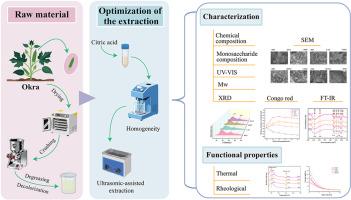The structural and rheological modulations of okra polysaccharides induced by high-speed shear integrated ultrasonic acid extraction
IF 11
1区 农林科学
Q1 CHEMISTRY, APPLIED
引用次数: 0
Abstract
This study developed a novel green extraction method of okra polysaccharides, high-speed shear assisted ultrasonic-citric acid extraction (HUCE), and its extraction mechanism and structure-function relationship were elucidated through comprehensive characterization, including polysaccharides yield, monosaccharide composition, molecular weight distribution, structural morphology, and thermal stability. Compared to citric acid extraction (CAE), high-speed shear-citric acid extraction (HSCE), and conventional hot-water extraction (HWE), HUCE demonstrated significantly improved polysaccharide yield (19.09 %). Monosaccharide analysis and FT-IR spectroscopy confirmed that all extracted okra polysaccharides exhibited characteristic functional groups of acidic polysaccharides, comprising rhamnose, arabinose, galactose, glucose, xylose, galacturonic acid, and glucuronic acid. HUCE-extracted polysaccharides showed higher uronic acid content (44.53 %) and total sugar content (76.03 %) than those obtained by the other methods. Moreover, the molecular weights of the polysaccharides ranged between 5168.82 and 5838.56 kDa, with the HUCE-extracted polysaccharides exhibiting the lowest one (5168.82 kDa). XRD and Congo red assays revealed that all four products possessed an amorphous structure with a triple-helical conformation. Importantly, the HUCE-derived polysaccharides demonstrated superior thermal stability and steady-state fluid behavior, suggesting their potential as a thickener or stabilizer in food applications. In conclusion, HUCE represents a highly promising extraction method for okra polysaccharides in terms of yield, purity, structural properties, and functional performance. This study provides a theoretical foundation for understanding the structure-function relationship of okra polysaccharides and offers valuable insights for their future applications in the food and pharmaceutical industries.

高速剪切一体化超声酸萃取对秋葵多糖结构和流变学的影响
本研究开发了一种新的绿色提取秋葵多糖的方法——高速剪切辅助超声-柠檬酸萃取法(HUCE),并通过多糖得率、单糖组成、分子量分布、结构形态和热稳定性等综合表征,阐明了其提取机理和结构-功能关系。与柠檬酸萃取法(CAE)、高速剪切-柠檬酸萃取法(HSCE)和常规热水萃取法(HWE)相比,HUCE法显著提高了多糖得率(19.09%)。单糖分析和傅里叶变换红外光谱证实,所有提取的秋葵多糖均表现出酸性多糖的特征官能团,包括鼠李糖、阿拉伯糖、半乳糖、葡萄糖、木糖、半乳糖醛酸和葡萄糖醛酸。huce法提取的多糖脲酸含量(44.53%)和总糖含量(76.03%)高于其他方法提取的多糖。多糖的分子量在5168.82 ~ 5838.56 kDa之间,其中hue提取的多糖分子量最低,为5168.82 kDa。XRD和刚果红分析表明,四种产物均具有三螺旋结构的非晶态结构。重要的是,huce衍生的多糖表现出优异的热稳定性和稳态流体行为,表明它们在食品应用中作为增稠剂或稳定剂的潜力。综上所述,从产率、纯度、结构性质和功能性能等方面来看,HUCE是一种极具发展前景的秋葵多糖提取方法。该研究为了解秋葵多糖的结构功能关系提供了理论基础,并为其在食品和制药工业中的应用提供了有价值的见解。
本文章由计算机程序翻译,如有差异,请以英文原文为准。
求助全文
约1分钟内获得全文
求助全文
来源期刊

Food Hydrocolloids
工程技术-食品科技
CiteScore
19.90
自引率
14.00%
发文量
871
审稿时长
37 days
期刊介绍:
Food Hydrocolloids publishes original and innovative research focused on the characterization, functional properties, and applications of hydrocolloid materials used in food products. These hydrocolloids, defined as polysaccharides and proteins of commercial importance, are added to control aspects such as texture, stability, rheology, and sensory properties. The research's primary emphasis should be on the hydrocolloids themselves, with thorough descriptions of their source, nature, and physicochemical characteristics. Manuscripts are expected to clearly outline specific aims and objectives, include a fundamental discussion of research findings at the molecular level, and address the significance of the results. Studies on hydrocolloids in complex formulations should concentrate on their overall properties and mechanisms of action, while simple formulation development studies may not be considered for publication.
The main areas of interest are:
-Chemical and physicochemical characterisation
Thermal properties including glass transitions and conformational changes-
Rheological properties including viscosity, viscoelastic properties and gelation behaviour-
The influence on organoleptic properties-
Interfacial properties including stabilisation of dispersions, emulsions and foams-
Film forming properties with application to edible films and active packaging-
Encapsulation and controlled release of active compounds-
The influence on health including their role as dietary fibre-
Manipulation of hydrocolloid structure and functionality through chemical, biochemical and physical processes-
New hydrocolloids and hydrocolloid sources of commercial potential.
The Journal also publishes Review articles that provide an overview of the latest developments in topics of specific interest to researchers in this field of activity.
 求助内容:
求助内容: 应助结果提醒方式:
应助结果提醒方式:


